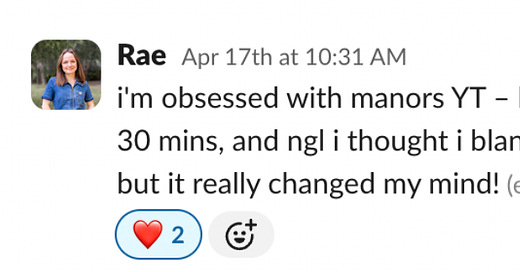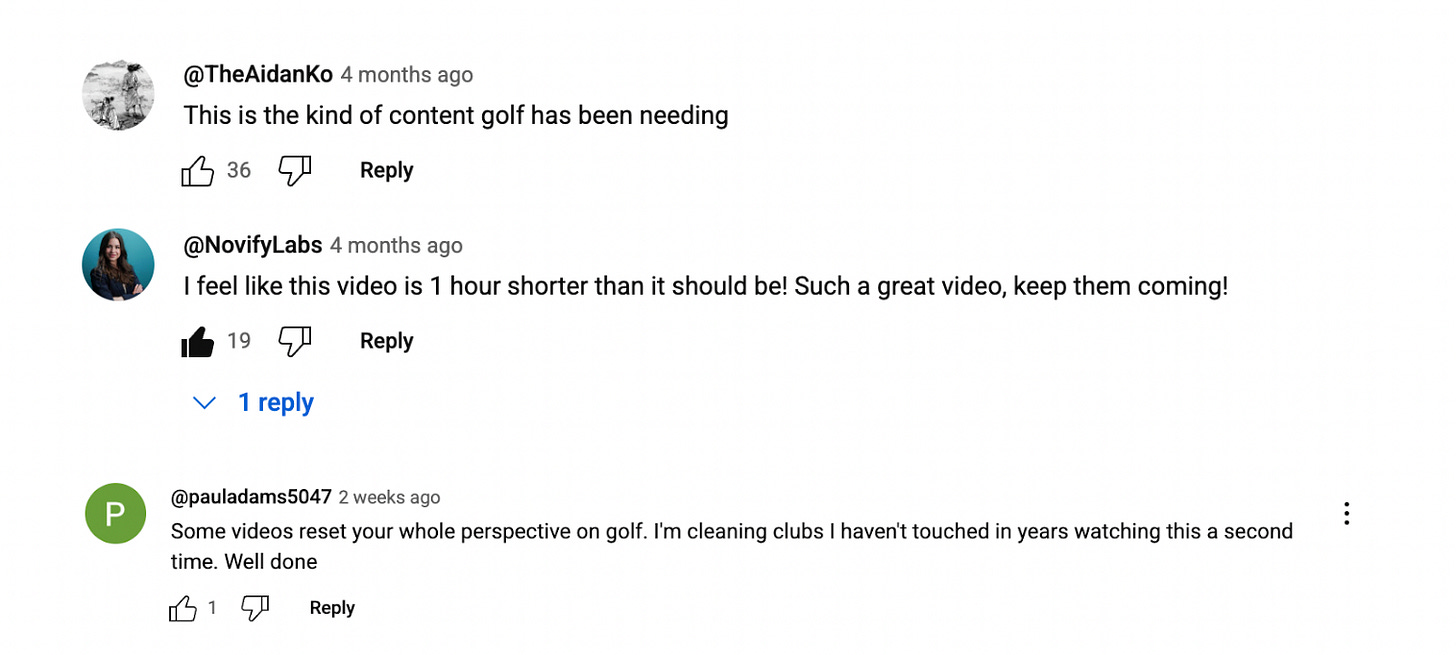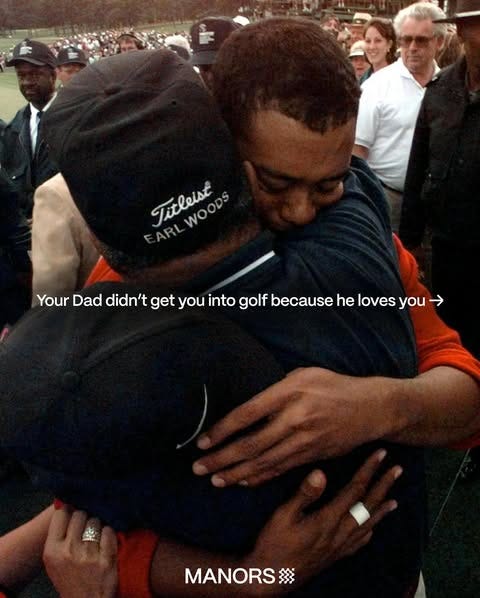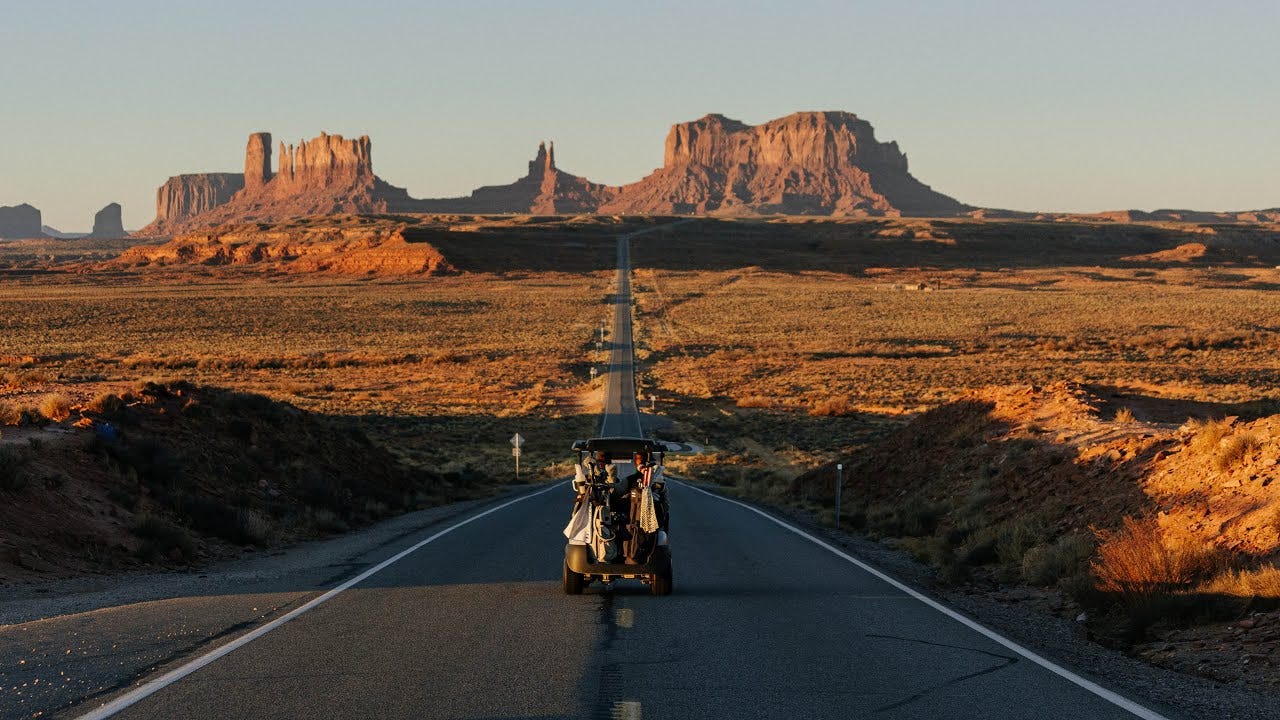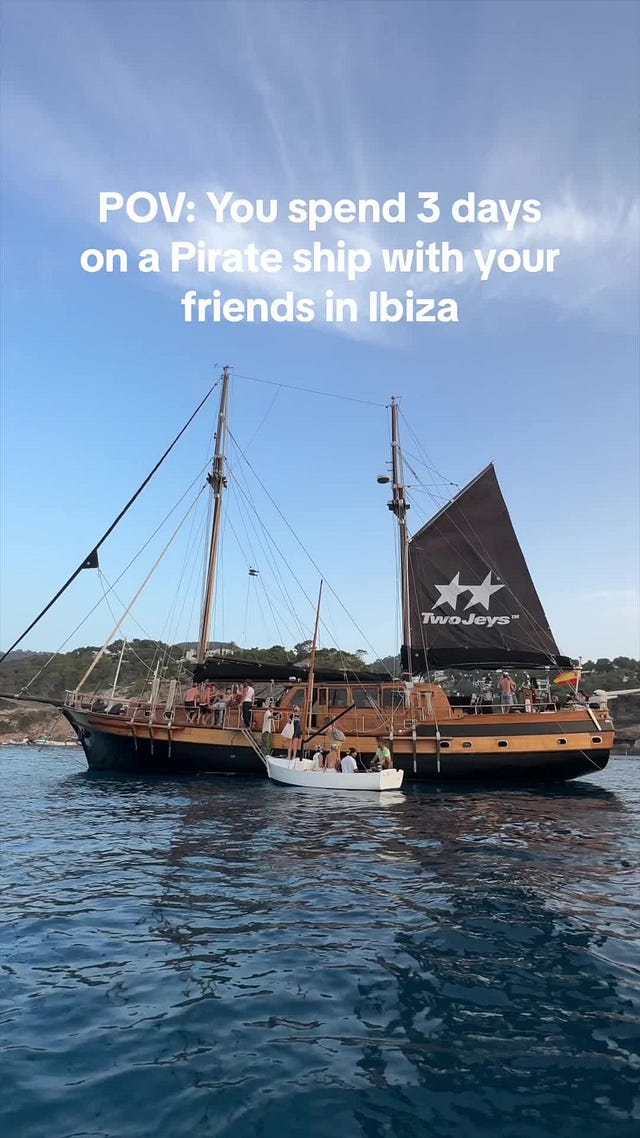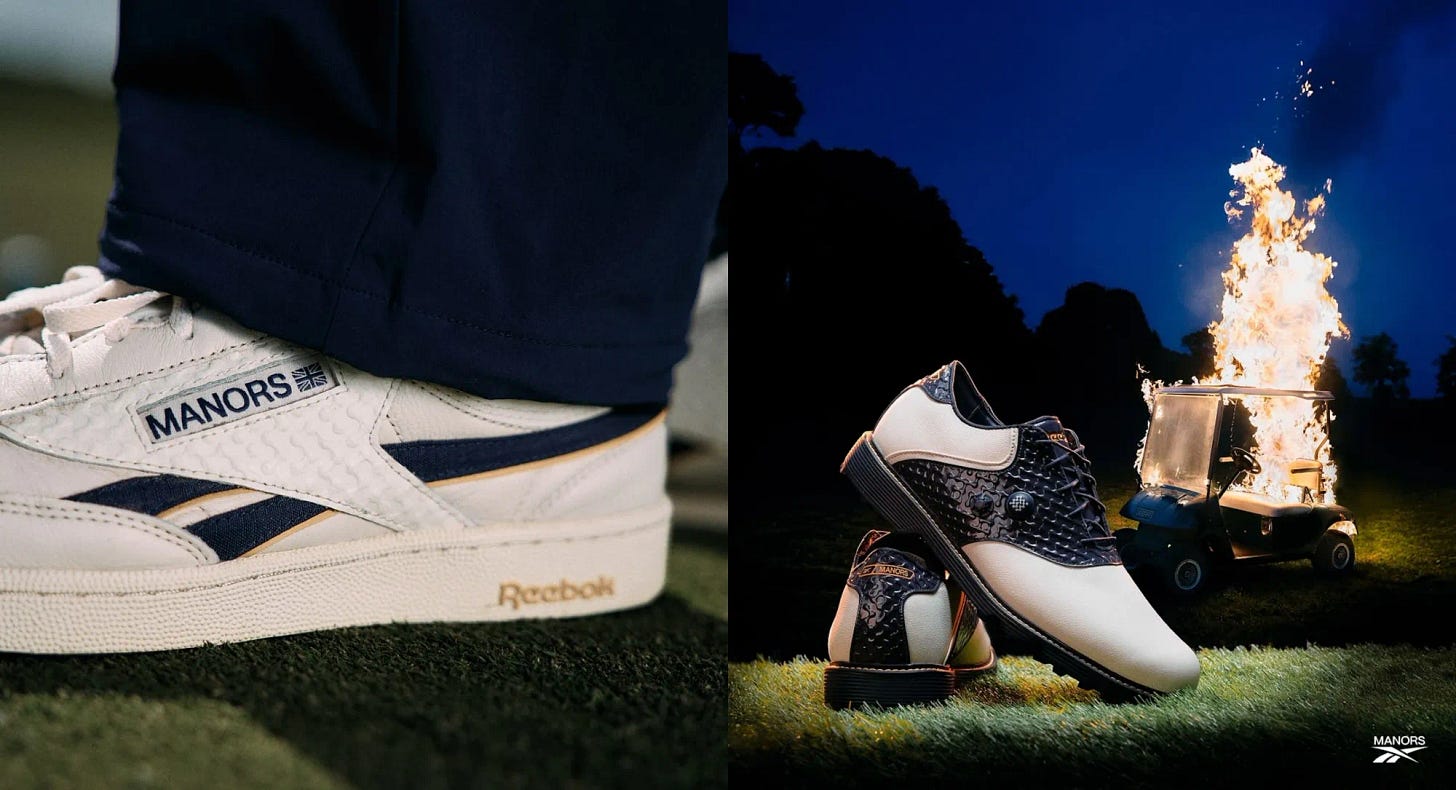The Manors Golf masterclass in marketing
Don't chase impressions (and sometimes, piss people off)
Rae, our Creative Lead, is obsessed with Manors’ YouTube. Content like a heartfelt deep dive into Japanese golf culture where respect, discipline and beauty converge (which ends with their team-member, and us, wiping away tears); an adventure into Arizona complete with an epic rodeo, euphoric hole-in-one at the WM Phoenix Open, and a moving monologue by Edgewater clan member and golfer Joseph Secody as he compares the indigenous hoop dance to the mentality you need on the course.
If Rae, our cat-loving crochet queen who hasn’t picked up a golf club in her entire life is enthralled by a 24 min golf film, imagine what it’s doing for actual golfers. This is not your average watch-my-swing video content.
It was always part of the vision for Manors – not just to sell golf polos but to shape golf culture. Push the sport forward. And we kept it front of mind when we worked together, helping them reposition from a golf-inspired fashion brand to sportswear for the course.
The strategy and story we created together focused on becoming the explorer brand in golf, taking cues from travel-intertwined sports like surfing and cycling that prioritise awe-inspiring content. It was centred around a clear hero and customer mindset we called the frontier golfer, in opposition to the fairway golfer (see moodboard below). This is someone more interested in collecting stories than scores, who was just as much there for the post-match pints as they were the chance of a hole-in-one. There was a line: “we’re about the journeys to parts unknown, the early mornings, the playing through the rain.” And watching influencers on Instagram get pummelled by 40mph winds on a Manors influencer event in Scotland – it’s safe to say that they’re living that story every single day.
And it’s paid off. Just a year on from their repositioning, Manors were up 859% YoY with a “monumental shift” away from wholesale towards direct-to-consumer sales with higher margins and stronger customer relationships. (Read the co-founder’s post about when to rebrand here). They’ve been worn by the likes of Travis Kelce and England footballer Declan Rice, partnered with the PGA tour on their series – A Change of Course (a line we brainstormed in our workshop) – and just came out with a collab with Reebok.
Watching them is a masterclass in marketing with real storytelling that rouses emotions and pushes all the right buttons to get people talking. We sat down with Alex, Marketing Director, to find out about what they’re doing, and what’s paying off.
Emily: We’re going to talk marketing buzzwords: content, community and collaborations mainly because it alliterates, but also because you guys do it so well. Firstly, the fact that Manors prioritises long-form video is rare, especially as a start-up and feels counter to what a lot of other people are doing right now. Why are you and is it paying off?
Alex Ames: When we rebranded two and a half years ago with you, we actually started with short-form content. It was cheaper, easier to produce, and better for building an audience. Long-form content, especially on YouTube, is time-consuming, expensive, and hard to get right. But there’s a business answer and a brand answer to why we prioritise it. The business answer is: attention is monetisable. If someone gives you 45 minutes of their time, they don’t just like your brand, they trust you as a channel. Some YouTube channels are making $150,000 per episode through sponsorship. So we’re not just building a clothing brand, we’re building an entertainment channel.
The brand answer is: these videos create deep connection. A like on Instagram is cheap. It’s one thing to get them to buy from a Google ad which costs you a certain amount of money to put in front of people who are already shopping for golf polos and get them to go “oh yeah I quite like that”. It’s another to do the work, maybe over two years even, and then when that person eventually finds you, they fall in love with you. 45 minutes with a character, a transformation, a story arc that builds emotional investment. That’s what turns viewers into lifelong fans. And ultimately that’s a business decision too: our customer lifetime value is huge and I think a big part of that is brand loyalty built through this kind of storytelling.
Emily: It always feels like you guys are really creating content for that hero we spoke about in our workshop – the frontier golfer. The explorer. How has having a laser focus on your mindset – who you’re for and who you’re not – shaped the kind of marketing you do.
Alex: We simplify everything to “a game to be explored” and that lens helps shape everything we do. And it’s fun because as a brand you get to take things to the extreme. So there are people that like to travel and play golf, but what’s the most dramatised version of that? Okay, we’re going to camp out on a golf course until we birdie every single hole. It’s going to take a week and it’s going to be fucking hard and brutal and you’re going to get to know the Shetland Islands.
Emily: There’s a travel-magazine feel to it. Not doing top ten bars in Arizona but meeting with the local chakra reader and looking into new age there…
Alex: Totally. And for golf that’s really different.
Emily: Do you think Luke (founder) being a film director before this and you working in photography gives you an advantage? And does it make it more affordable?
Alex: Luke isn’t actually directing the films, but what he is doing is creative directing. He’s a master briefer. He knows exactly how to get what he wants out of a shoot. That makes a huge difference. I also think something people don’t talk about in the brand world is that when you have a great brand, and you’re doing really cool things, people want to work with you and it also gets more affordable for that reason. Creatives want to work with you because they know their creativity will be valued, they’ll make great work.
Emily: What makes a killer creative brief?
Alex Ames: Over-reference. Know your tone, music, colour grade. Show ten examples. People underestimate how much easier it is to get what you want when you show what you want.
Emily: What’s an example or a detail where you guys went the extra mile to get the shot or the piece of content?
Alex: For SS25’s “Drive to Nowhere,” we hired a local Navajo producer, found a golf cart three hours away, and drove it on the back of a truck to one of the most famous roads in America on native Navajo land. We got up at 5 a.m. and held traffic on both sides to get a five-second shot. But it went everywhere – our newsletters, our campaign print, the film teaser. It became the campaign.
Emily: Are there other brands you admire for content?
Alex: Yeti for long-form. Satisfy Running. Jacquemus for short-form. TwoJeys are great. It’s a bit cheesy and cliche but it’s all about that idea that good is the enemy of great. So many people make good content, but they don’t spend the extra amount of time thinking about going the extra mile, taking the extra amount of time being like what is mental that an audience isn’t going to move past. So TwoJeys for example rented a real-life pirate ship and put loads of influencers on it to sale the mediterranean with their logo as the sail.
Emily: Talking of influencer trips, you’ve done a bunch that look like so much fun. It makes me want to golf. Was that always part of the plan?
Alex: When we launched the brand we had a really big sales spike – but after a couple of months, things dipped. We call it ‘the dark ages’. And we realised if you’re not actively doing things to stay front of mind, people move on. So we hosted a golf-day in London, and by hook or crook we got about 30 cool people together and we noticed sales pick up again. So we built a whole strategy off it. So not just a golf day in London, but an explorer, adventure trip to St Andrews. We called it the first frontier from the work we did with you and all the copy – from menus to invites – was super branded for this premium explorer. “Come with us to where golf began so that together we can see where it’s going next.” We spent way more money than we had, JoJo (co-founder) was pulling rabbits out of hats and got this massive golf influencer to come by just paying for his flights. But it worked. Luke made it into a film, everyone got on so well and it was exactly what we’d imagined for the brand. Since that we do one every year.
Emily: The latest thing you’ve done is a collaboration with Reebok – why did you collaborate with them?
We’ve been approached for a few collabs that we’ve said no to. This creator did a video on it the other day and called it brand soup: essentially shit collaborations where it’s just like – slap the logo on, distribute from both channels, make money. And we didn’t want to do that. But Reebok were getting back into golf. They’ve got this incredible British golf heritage. Back in the ’90s they had two really disruptive, irreverent players who were kind of the bad boys of golf and that history just fit with us. There was also this iconic technology, The Pump, which was huge back then. So there was genuine substance and the collab made sense: two disruptive British brands coming together.
Emily: The campaign was all around “No thanks I’ll walk” so creating some conversation around golf carts vs walking. Was the aim always to piss people off with that?
Alex: Yeah, kind of! “No thanks, I’ll walk” was actually an old Reebok campaign line Luke found. It felt perfect. In Britain we walk the course. In the States and in hotter countries, a lot of people use golf carts which also kind of comes with this bro culture – the angriest, most annoying golfers on the golf course are the drunk bros who play music in their golf cart or whatever. But there are a lot of people who also respect walking the course.
So we wanted to piss off the 10% that would hate it and shout about it. Talk to the 10% of people who would love that message and defend it. And create a campaign that travels. The rest of the 80% now know who you are. That’s a win. Big brands can’t really say anything interesting because they’re afraid to piss people off. But we can speak directly to our explorer – and that’s powerful.
The Advice (by Alex)
Get good mentors. Reach out on LinkedIn and usually you’ll find someone who has been through what you have and are willing to have a meeting where you just ask loads of questions. Hundreds of questions.
YouTube. For every subject you can find one or two really great leaders on it. We have consumed sooo much content on everything in marketing – storytelling, how to create a successful campaign, social media.
The Vortex (by Alex)
Watch
This guy is nauseating but he is a genius at content strategy.
Everyone knows Rory Sutherland but this one is good.
Mr Beast - learn from the master of YouTube.
Listen
This is excellent. An interview with the woman who built Racquet social club in LA, who are doing for tennis what manors are trying for golf.

